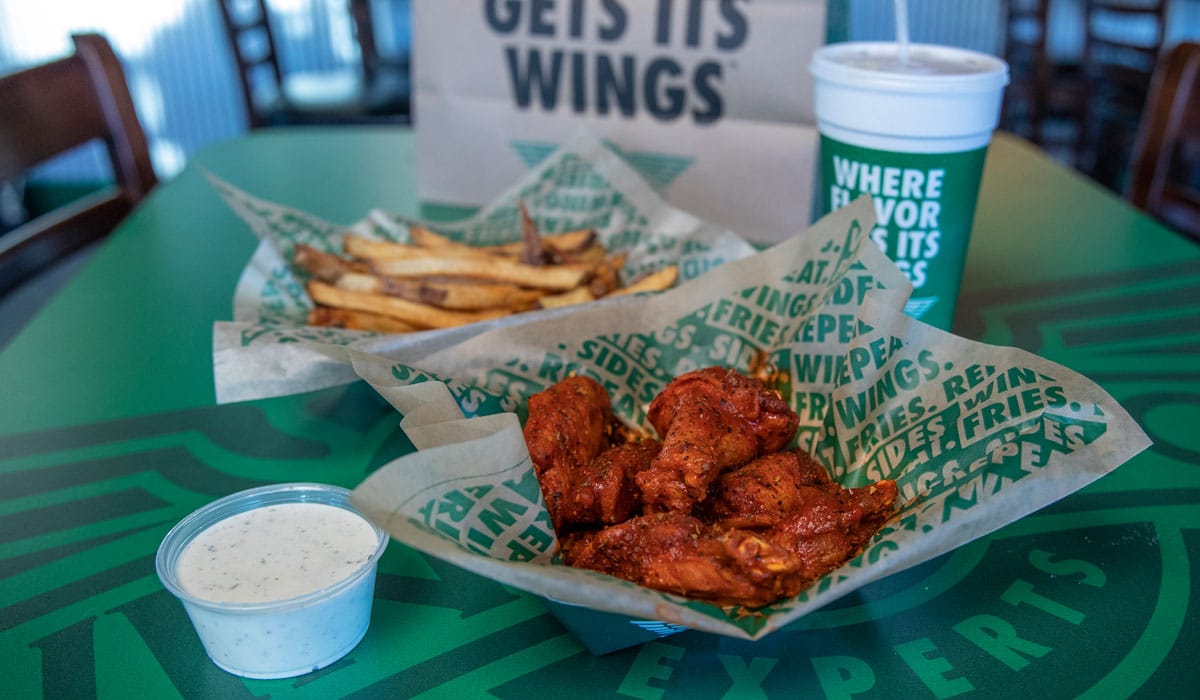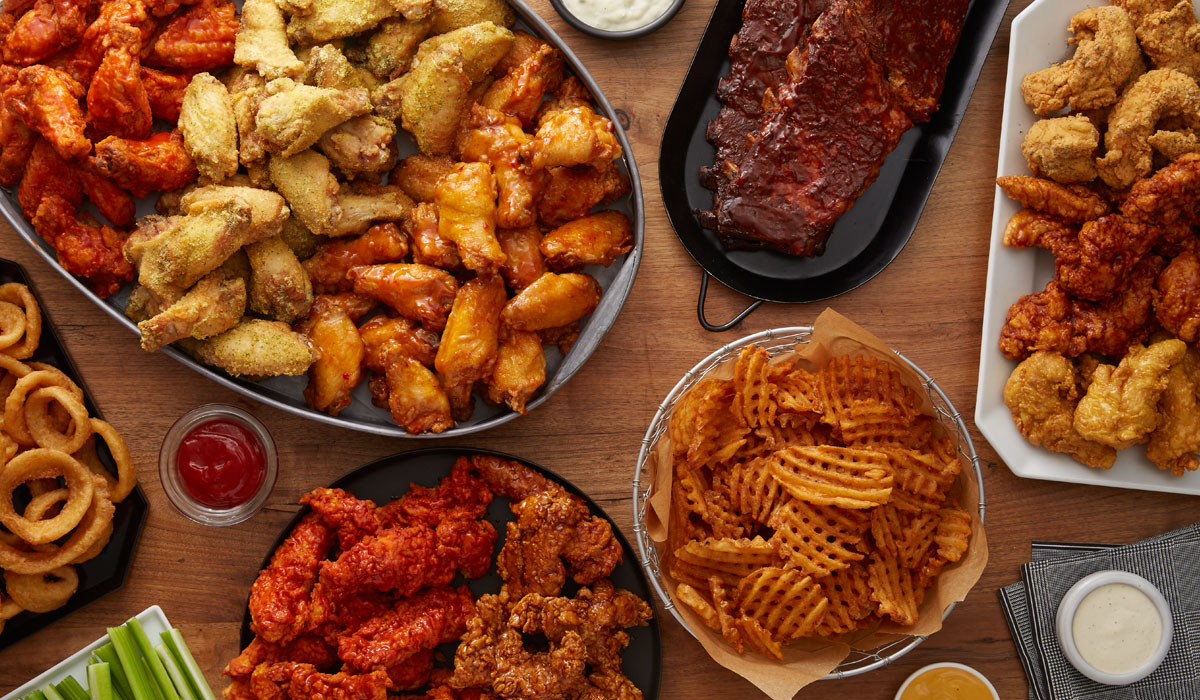Wingstop often emphasizes that it’s in a “category of one,” but when it comes to battling supply chain issues, the fast casual is looking to follow the lead of its larger-scale peers like Dunkin’ and Starbucks and even those outside the industry.
CEO Charlie Morrison told analysts Wednesday that the wing concept is working with franchisees to evaluate every phase of the chicken supply chain to gain more control and mitigate future volatility.
“We’re still trying to figure out exactly how that manifests itself, but I think it’s incumbent upon us to not allow such volatility to continue for the long haul, which we believe we can address,” Morrison said during the brand’s Q3 earnings call.
The average spot price for bone-in wings reached a record $3.22 per pound in Q3, an 84 percent increase year-over-year. However, through price mitigation strategies with Wingstop’s largest poultry suppliers, restaurants partially offset the inflation and saw an effective increase of 49 percent. Food, beverage, and packaging costs increased 11.7 percent at company-run stores compared to last year.
READ MORE: Wingstop Softens Inflation with Soaring Sales
Since then, spot prices have reduced to $2.87 per pound, and frozen inventory stocks are approaching 2019 levels, which CFO Alex Kaleida said is a lead indicator of deflation. Although prices are trending in the right direction, Morrison said the company remains “laser-focused” on controlling more of the chicken pricing and supply process and relying less on spot prices.
He added that chicken wing prices must decrease to well below $2 per pound for Wingstop to feel comfortable.
“The thing that is the challenge for us are the things we can’t necessarily control right in front of us, the macro headwinds,” Morrison said.
In response, franchisees will raise menu prices by an additional 4 to 5 percent, resulting in a 10 percent increase overall this year. Historically, the brand has used a 1 to 2 percent pricing cadence each calendar.
But Wingstop hasn’t received any noticeable pushback from consumers, as seen by its latest sales trends. U.S. same-store sales rose 3.9 percent year-over-year, and 29.3 percent on a two-year basis. Also, AUV has risen to roughly $1.6 million, pushing Wingstop’s sales to investment ratio to 4:1. Restaurants are entering the comp base with $1.2 million in AUV, up from $900,000 for stores built in 2019.
In October, comps grew 7 percent, despite lapping sales in the high teens last year—keeping the brand on pace to achieve 18 straight years of positive comp sales. Wingstop changed its full-year guidance to same-store sales growth of between 7-8 percent, an increase from mid-single digits.

Morrison said Wingstop’s current pricing strategy will be set for the near-term, and then the company will revert back to its typical cadence.
“We’ve always believed that we do have pricing power in this brand. And while it’s challenging right now I think that will stabilize,” he explained. “As we look to the wing market, will it stabilize and get back to historical levels? We don’t know. And we’re not going to just bank on that. That’s why we’ve commented several times that we’re going to look at strategies where we can take more control of the situation.”
In an effort to reduce volatility, Wingstop has been determined to use more parts of the chicken, which led to the launch of virtual brand Thighstop toward the end of the second quarter. The concept was originally available only through DoorDash and a native website, but the menu items were placed on Wingstop’s menu in September, doubling thigh sales.
Morrison said the trajectory of thigh products is similar to when Wingstop introduced boneless wings many years ago.
“We definitely think that the introduction of thighs through Thighstop was the right strategy and yields the desired outcome, which is not only to just create an opportunity for an item to mix at a lower cost level than what the bone-in wings are, which it has done, but we also know that it has a meaningful effect on our ability to secure entire birds, instead of just buying the wings and some of the breast meat off of the product from the spot markets,” the CEO noted.
READ MORE: Wingstop CEO: Labor Shortage, Inflation Won’t Stop Growth
The other major inflationary pressure is labor, but Morrison believes Wingstop is in better shape than most because of the brand’s streamlined kitchen operation and small roster sizes; a restaurant typically only requires roughly 16 employees. Labor costs were 24.6 percent in Q3, a 1.2 percentage point decrease from last year. The drop was mostly due to lapping COVID incentives; it was partially offset by investments in wages, hiring bonuses, and training.
Morrison thinks the lean labor model could be improved even further. Out of the nearly 1,500 stores in the U.S., only about 200 have reopened in-store dining, leading Wingstop to believe it can reduce the size of dining rooms going forward and move further into its accelerating digital and delivery business.
Digital sales represented 61.6 percent of sales in Q3, in line with last year’s mix. Delivery—which carries a higher average check—is accounting for 27.2 percent, almost three points better than 2020.
“I think our franchisees, as well as all of us corporately, feel like the digital side of our business is really what the long-term is all about, how can we create efficiencies inside the four walls of the restaurant to mitigate some of these challenges we’re seeing in the near-term on labor,” Morrison said.

Morrison acknowledged that Wingstop has seen the impact of high turnover, which has put pressure on training new employees and raising wages to attract top talent. Even with those investments, the CEO said restaurants are still generating high cash flow. For example, AUV of company-run stores is more than $2 million, and they’re earning more than $200,000 in cash per unit on a $400,000 investment. This performance “leads to a sense of confidence, not only among us, but our franchisees, as well, that we’ll weather this storm.”
Additionally, he said the high off-premises mix insulates Wingstop from any meaningful negative impact on the guest experience.
“We don’t like to have our rosters challenged in terms of their size, but we know that we can operate at lower levels and still deliver a great guest experience,” Morrison said. “But our focus is not only in our company restaurants, but also in our franchise system is to get staffed up and make sure we maintain that by way of adapting to the macro environment that we’re seeing in front of us.”
In terms of unit growth, Wingstop has faced supply chain challenges associated with equipment, but it hasn’t meaningfully impacted development, Morrison said. In fact, the chain achieved another record quarter with 49 net new restaurants in Q3. The brand finished the quarter with 1,673 stores systemwide, a nearly 200-unit increase year-over-year. Domestically, Wingstop finished with 1,461 units, compared to 1,277 in 2020.
Morrison said spot market wing prices dropping from $3.22 to $2.87 equates to $75 million of cash flowing back into the system, enough to build 185 new restaurants. In addition, Wingstop was able to leverage its ad fund surplus and rebate a portion back to franchisees to fuel further growth.
“While we are facing near-term inflationary pressures, our growth fundamentals and long-term potential of operating over 6,000 restaurants worldwide remains unchanged and our brand partners share that vision,” The executive said. “We are very pleased with this record pace of restaurant development and the top line growth our brand has seen, which certainly provided relief from the inflationary environment we operate in today.”
Systemwide sales increased 16.7 percent to $594.3 million in the third quarter. Adjusted EBITDA grew 16.2 percent to $21.4 million.










